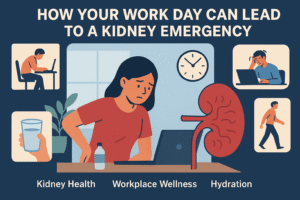Needing dialysis does not always mean spending hours each week at a clinic. If you are living with end-stage kidney disease, there is another way — one that gives you more say in how your day goes. Many patients are managing ESRD right from their own homes, and they are doing it safely. Home peritoneal dialysis for ESRD is more flexible than you might think — and yes, it works.
We help you decide if it fits. No guesswork, no pressure — just clear answers that match your life.
What It Is and How It Works
Peritoneal dialysis uses part of your body, not a big machine, to get the job done. Inside your belly is a thin layer called the peritoneal membrane. It works as a filter. A cleansing fluid goes into your abdomen through a small tube. After a few hours, that fluid comes out, taking waste with it.
That back-and-forth cycle is called fluid exchange therapy. And once you get the hang of it, it becomes part of your rhythm. You are not hooked up to a machine unless you are doing automated nighttime treatments. Most of the process happens quietly, and often while you sleep.
Why People Choose to Do It at Home
Clinic visits three times a week do not work for everyone. If you are balancing a job, caring for family, or simply prefer more privacy, at-home dialysis care could be a better fit.
Why patients love it:
- No fixed clinic schedule
- Less disruption to daily life
- Greater control over your routine
- Gentler on the body compared to some hemodialysis methods
- Done overnight or in quiet sessions during the day
You do not have to give up your time to sit in a chair at a center. You dialyze where you live, on your terms.
How the Setup Works
First, we place a small tube (catheter) into your abdomen. That is how the dialysis fluid moves in and out. Then we walk you through how the process works — slowly and step by step.
There are two types:
- CAPD: Manual exchanges you do yourself, four to five times a day
- CCPD/APD: Automated overnight treatments using a small machine
You choose what fits your routine. Some people even switch back and forth depending on their day-to-day needs.
Is It Safe to Do Peritoneal Dialysis at Home?
Yes — when done right. We train you carefully before you ever begin. You learn how to keep everything sterile, track your numbers, and spot any early signs of infection. We are always here to answer questions, adjust your routine, and stay involved as much as needed.
Home peritoneal dialysis for ESRD is used by thousands of people across the country. It is safe, proven, and more comfortable than many expect.
Is It Right for Everyone?
Not always. If you have certain abdominal conditions, scar tissue, or frequent infections, peritoneal dialysis might not be ideal. Also, it requires commitment. You will need to manage supplies, stay organized, and follow your exchange schedule carefully.
But if you are someone who wants control over your care, fewer restrictions, and more time in your own space, this method may be the right call.
You can always connect with our dialysis care team to talk it through. No pressure. Just real answers.
Let’s Make Your Life with ESRD More Livable
Dialysis is not easy — we know that. But with the right plan, it does not have to take over everything. At Southern Oklahoma Kidney Center, we help patients live fully while staying safe. Home peritoneal dialysis for ESRD is not just a treatment — it is a lifestyle option that gives you some of your day-to-day freedom back.
If that sounds like something you want, let us help you make it happen.




